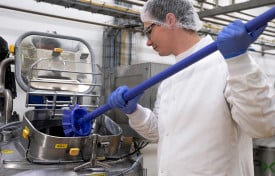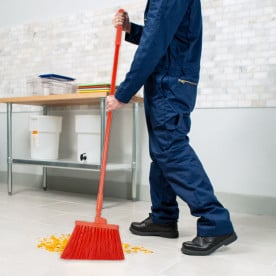Vikan

- April 07, 2021
Ah, the beauty and purity of a new cleaning tool. Freshly removed from any packaging, and unsullied by the elements: nothing but possibility ahead of it. Whether you enjoy opening new tools as much as I apparently do, or you are more in the “pop it open, because there is a ton of stuff to do” camp, there are a few tips that our friends from Remco have provided to get the best out of your new cleaning tool. These simple steps help to ensure safety before the first use.
How to Prepare a New Cleaning Tool for Use
New cleaning tools—especially those sealed in plastic pouches like the ones from Vikan® and Remco—often look like they’re ready for use right out - March 31, 2021
Springtime brings many new colors, from the flowers popping up in gardens to the spring and summer produce offerings at the grocery store. During this colorful time of year, it might be the perfect opportunity to take a look at color-coding in your facility, whether that means starting a new color-coded program or expanding an existing program.
Nelson-Jameson has expanded our color-coded program once again with the release of our 2021 Color-Coded Catalog. This year's catalog has grown to 68 pages of products that are designed to help prevent allergen migration and cross-contamination. A complete color-coded program helps to lay the foundation for a solid food safety program, and can help minimize the risk of cross-contamination.
Why choose a color-coded system? A complete color-coded system helps promote organization and efficient workflow. Designating critical control areas and zones helps your sanitation program by ensuring that the tools stay in the areas in
- March 25, 2015
It is quite easy to go through the day without taking a second look or give a second thought to the brushes we may use in our food industry operations or in our homes. Considering the vigorous workouts that we give our brushes, and the harsh conditions we expose them to, these workhorses are probably, at best, considered a basic tool with a basic function. Yet, the brushes we utilize today in industrial and domestic realms are the result of continuously morphing science and engineering standards.
For instance, filaments, the frontline soldiers in scouring, are put under a great deal of constant duress. In order to ensure that filaments (which can be made of several different materials, including polyester and polypropylene) don’t shed like needles from a dry Christmas tree, various settings have been developed to both allow durability and reflect standards of sanitary practice.
For basic cleaning, filaments have been traditionally set in with staples. Filaments are held in place, allowing for a level of durability and the ability to retain the filaments. However useful, staple-set brushes, because of their setting do permit small pieces of debris to get caught within the setting and may allow the growth of potential bacteria that get caught there. Such general-use brushes may work within certain circumstances; yet, they present some issues when contending with ensuring sanitary standards in food industry environments.






